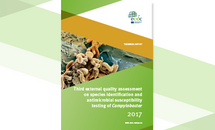Third external quality assessment on species identification and antimicrobial susceptibility testing of Campylobacter, 2017
This report presents the results of the third round of the EQA on AST for national public health laboratories for Campylobacter (Campylobacter EQA3-AST) within the Food- and Waterborne Diseases and Zoonoses Network (FWD-Net).
Executive summary
Since 2008, it has been possible for European Union/European Economic Area (EU/EEA) countries to report antimicrobial resistance (AMR) data to the European Surveillance System (TESSy) as part of routine surveillance for salmonellosis and campylobacteriosis. In 2014, the European Centre for Disease Prevention and Control (ECDC) published an EU protocol for harmonised monitoring of AMR in human Salmonella and Campylobacter isolates (updated in 2016). In addition, ECDC launched an external quality assessment (EQA) scheme for antimicrobial susceptibility testing (AST) for Salmonella and campylobacter with the purpose of supporting the implementation of the EU protocol in EU/EEA countries and to get an overview of the quality of the AMR data reported to ECDC.
This report presents the results of the third round of the EQA on AST for national public health laboratories for Campylobacter (Campylobacter EQA3-AST) within the Food- and Waterborne Diseases and Zoonoses Network (FWD-Net). The objectives of this EQA3-AST were to:
- determine the accuracy of quantitative AST results reported by participants
- identify common laboratory problems related to the guidance in the EU protocol; and
- assess the overall comparability of routinely collected AST data from national public health reference laboratories (NPHRLs) across Europe.
The Campylobacter third EQA-AST covered species identification and AST in Campylobacter spp. Twenty-three NPHRLs in EU/EEA countries participated in the EQA that took place from February 2017–January 2018. In addition, six EU candidate/potential candidate countries participated in the EQA. This report focuses only on the results and evaluation of results from EU/EEA countries.
Bacterial strains for the EQA were selected according to their current relevance to public health in Europe and shipped to participating laboratories. Testing and reporting of three mandatory antimicrobials (ciprofloxacin, erythromycin and tetracycline) were required for participation in the EQA and one additional optional antimicrobial, gentamicin, could also be reported. The test results from all participants were evaluated and individual feedback
provided.
The test results for antimicrobial susceptibility were analysed by two different approaches. Laboratories reported the results as values from either disk diffusion (DD) or, when using dilution or gradient strip, the minimum inhibitory concentration (MIC). These values were compared to the values established by the EQA provider and the mm difference for DD values or number of dilution differences for MIC values were calculated. Reported quantitative results were further interpreted as wild type (WT) or non-wild type (NWT) based on the available epidemiological cut-off values (ECOFFs) from the European Committee for Antimicrobial Susceptibility Testing (EUCAST) and the interpretation compared to the expected result established by the EQA provider. It was mandatory to report the species identification (C. jejuni or C. coli) as this is a requirement for the correct interpretation using EUCAST ECOFFs.
All laboratories performed species identification and submitted results for the mandatory antimicrobials ciprofloxacin, erythromycin and tetracycline for a total of seven bacterial strains. Thirteen laboratories also reported results for gentamicin.
Overall, there was good correspondence between the expected results established by the EQA provider and those reported by participating laboratories.
All participating laboratories except one were able to correctly identify the Campylobacter species of the seven test strains. One laboratory attributed the wrong species for two strains. For the mandatory antimicrobials, the relative accuracy, i.e. the percentage of DD and MIC results that were within the accepted range from the expected result, was 79% for both disk diffusion and MIC methods. With the exception of one tetracycline result, all reported DD results were correct when interpreted with the EUCAST ECOFFs. For MIC, 97% of the interpreted results were correct. This indicates that it is reasonable to compare routinely collected AST results from NPHRLs across Europe when interpreted with the EUCAST ECOFFs. The performance of the individual laboratories varied substantially compared with the expected values. For the mandatory antimicrobials, the percentage of correct quantitative results varied from 52–100% for both DD and MIC results. This implies that it is feasible to improve the quality of AST data generated in some of the FWD laboratories. No common laboratory problems related to the guidance in the harmonised EU AST protocol were identified, but certain laboratories did not comply entirely with the protocol and it is of concern that some reported DD results for the reference strains that did not comply with the recommended EUCAST range.
The surveillance system that has been implemented as part of TESSy relies on the capacity of FWD-Net laboratories to produce comparable AST results. The overall results from the Campylobacter EQA3-AST indicate that it is feasible to compare AST results from FWD-Net laboratories.






